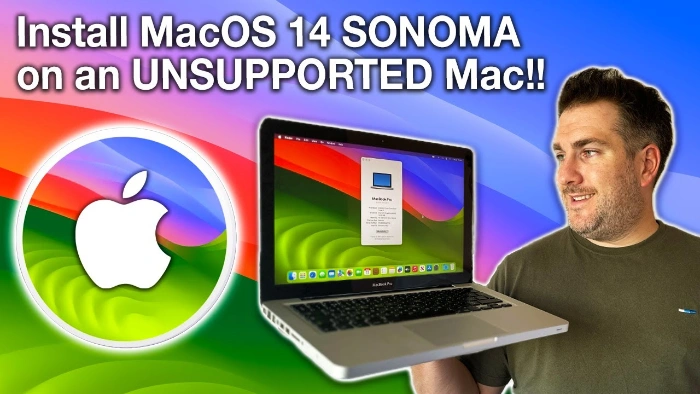Are you clinging to an older Mac that’s been left behind by Apple’s latest macOS updates? You’re not alone. Many users find their perfectly functional MacBooks becoming obsolete simply because they can’t run the latest macOS. But what if you could breathe new life into your old Mac by installing macOS Sonoma? This article will guide you through the process of installing macOS Sonoma on unsupported Mac devices, particularly those manufactured between 2008 and 2017. To kick things off, make sure you have a USB stick with at least 16GB of storage. Let’s dive in!
Hardware Upgrades: Making Your Old Mac Ready
If your Mac was manufactured in 2012 or earlier, you’ll likely need to make some hardware upgrades to ensure a smooth experience with macOS Sonoma. Specifically, you should aim for at least 8GB of RAM and an SSD hard drive. These upgrades are not just bells and whistles; they are essential for running the new OS efficiently. If your older MacBook doesn’t meet these requirements, consider installing Ventura OS as an alternative.
Preparation is Key: Back Up Your Data
Before you take the plunge into installing a new operating system like macOS Sonoma, it’s absolutely vital to ensure that all your important data is securely backed up. This is a step you simply can’t afford to skip, as the risk of data loss during an OS installation is not something to be taken lightly. The most reliable method for backing up your data on a Mac is by utilizing Time Machine, Apple’s native backup solution that comes pre-installed on your device. Time Machine is incredibly user-friendly and efficient, allowing you to create a snapshot of your entire system, including files, settings, and applications. By doing so, you create a safety net that you can revert to in case anything goes awry during the installation process. In essence, this step is non-negotiable and serves as your insurance policy against the potential nightmare of losing valuable data.
Software Update: The Preliminary Step
Before you embark on the journey of installing macOS Sonoma on your older Mac, it’s imperative to first update your current operating system to the most recent version that your hardware can support. This preliminary step serves multiple purposes. Firstly, it ensures that your system is primed for the new update by making it as compatible as possible with macOS Sonoma. This is crucial because each new version of macOS often builds upon the architecture of its predecessors, and having the latest supported version can minimize compatibility issues. Secondly, updating your current macOS to the latest version it can support often includes important security patches and performance improvements that can be beneficial when transitioning to a new operating system. By taking this step, you’re effectively reducing the likelihood of encountering glitches, bugs, or other installation issues that could otherwise disrupt the smooth transition to macOS Sonoma.
Tools of the Trade: Open Core Legacy Patcher
In order to streamline the installation process of macOS Sonoma on your older Mac, you’ll need to employ a specialized software tool known as Open Core Legacy Patcher. This invaluable piece of software serves as a crucial bridge between your outdated hardware and the new operating system. Essentially, Open Core Legacy Patcher modifies the system in a way that allows older Mac models, which are not officially supported by Apple for the new macOS versions, to successfully run these updates. It achieves this by patching the system files and enabling compatibility features that are otherwise locked or unavailable on older machines. To ensure you’re using the most stable and up-to-date version of this tool, it’s highly recommended to download Open Core Legacy Patcher directly from its official website. Doing so will provide you with the latest patches and features, thereby maximizing your chances of a successful and hassle-free macOS Sonoma installation.
Downloading macOS Sonoma: The Safe Way
Arguably one of the most critical phases in this step-by-step guide for installing macOS Sonoma on your older Mac is the act of downloading the operating system itself. As emphasized in the instructional video that serves as the foundation for this article, it’s vitally important to source macOS Sonoma directly from Apple’s own servers. This recommendation is far from trivial; it’s a safeguarding measure designed to ensure the integrity and security of the operating system you’re about to install. By downloading directly from Apple’s servers, you are essentially guaranteeing that the version of macOS Sonoma you receive is the most up-to-date, free from any bugs, malware, or viruses that could potentially compromise your system. This is a particularly important consideration, as an infected or buggy operating system could lead to a multitude of issues, ranging from minor annoyances and system glitches to severe security risks and data loss. In summary, by procuring macOS Sonoma directly from Apple’s official servers, you’re taking a significant step towards ensuring that your updated system will be as secure, stable, and reliable as it can possibly be.
The Installation Process: Proceed with Caution
The video shows you what you need to do to install macOS Sonomoa on older and unsupported Macs, you should always backup your Mac before you try to install software that is not supported by your Mac as it could cause an issue on your Mac.
Summary
Installing macOS Sonoma on an older, unsupported Mac is not only possible but also a great way to extend the life of your device. With some hardware upgrades, careful preparation, and the right tools, you can enjoy the latest features and security updates without investing in a new machine. So why let your old Mac gather dust when it could be running like new? Follow this guide and give your Mac the update it deserves.
Source & Image CreditL: Matt Talks Tech


